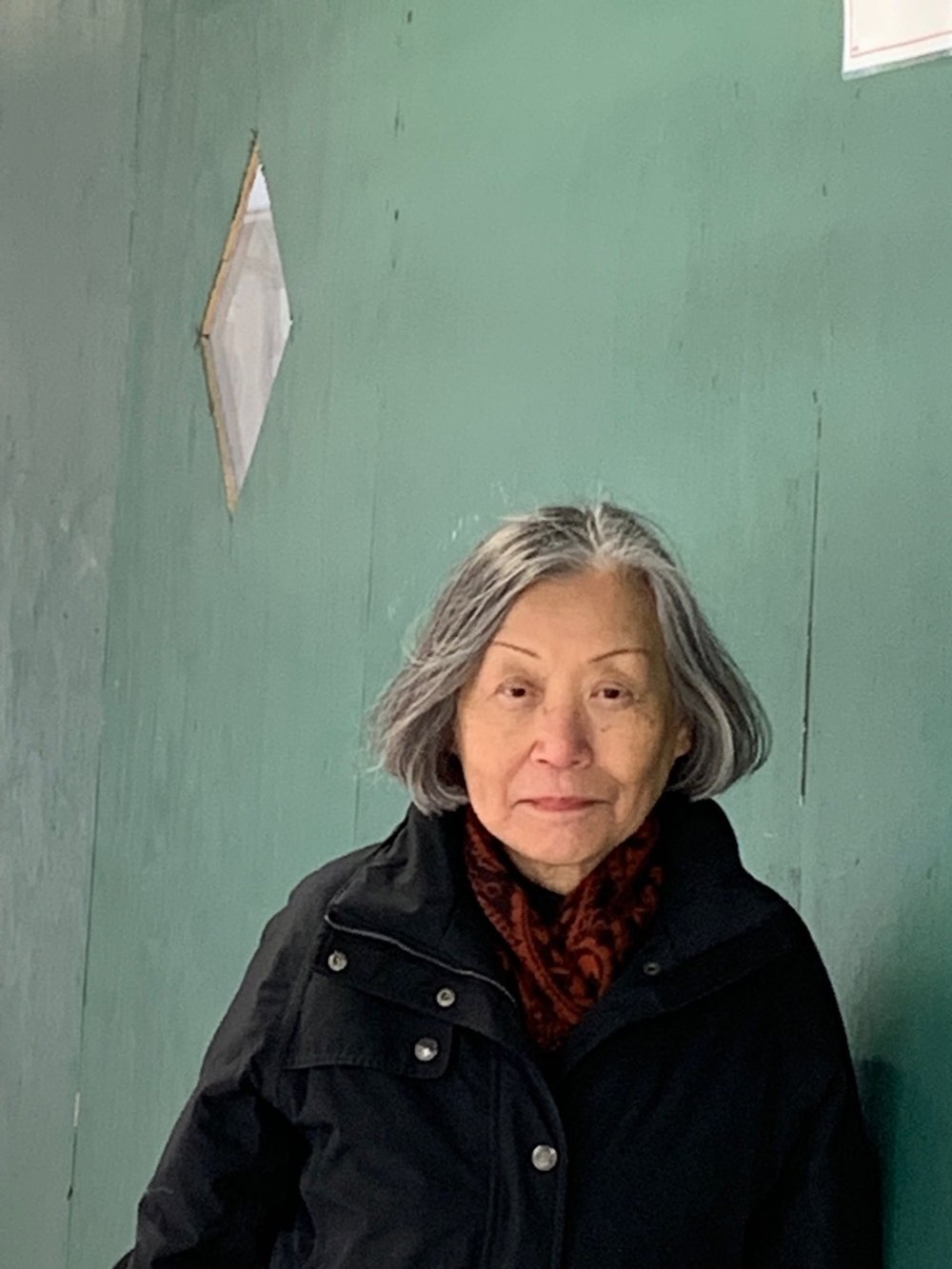TOP | EXHIBITION VIEW | HIDENORU ISHII | FUMI NAGASAKA | JEREMY YUTO NAKAMURA | JUNKO YODA
HOME > EXHIBITIONS > POST NO BILLS
Post No Bills
Hidenori Ishii,
Fumi Nagasaka,
Jeremy Yuto Nakamura,
and Junko Yoda
February 29 – March 24, 2024
Opening Reception:
Thursday, February 29, 6–8pm
Click here for RSVP
A Post No Bills notice is an assertion that a wall is sacrosanct, which is a fundamental misunderstanding of the city, where signage both legal and illegal accumulates like wild foliage. Each surface in the urban environment is a potential palimpsest, where message upon message tells its tale as days, seasons, and years come and go.
The signs that populate the walls of a city are akin to tattoos. They are dispatches of personality and intent, be they graffiti or guerilla marketing. A Post No Bills notice is a futile gesture meant to stem the flow of the city expressing itself. In this way, the city dweller who wants their voice to be heard might take each instance of Post No Bills as not just an invitation, but even as a challenge.
In this exhibition, four artists react and act upon the idea of the Post No Bills notice. With a variety of mediums and mindsets, we see a small sampling of the chorus of voices that populate New York City vying to be heard, fighting to be seen, and posting bills wherever and however they can.
A City In Flux
– By Jesse Pearson
Each artist in Post No Bills is a New Yorker finding different ways to represent the environment that surrounds them. In their art, we found a gamut of approaches and surprising ways to think of the mutable nature of this city. This is because a Post No Bills notice is two things at once: A dogmatic restriction and a harbinger of coming change. Behind each utterance of “Post No Bills” a kind of evolution is at work.
The photographer Fumi Nagasaka interacts with the diamond-windows found in construction site walls, but with a series of whimsical portraits. By placing us, the viewer, inside the construction site and having her subjects look in upon us, a reversal is performed. We are the spectacle behind the hastily- erected wall. These curious faces, these people who were before this moment our neighbors, are given the power to scrutinize us. But this dynamic, in Nagasaka’s deft hands, possesses a playful, friendly quality.
Hidenori Ishii not only recreates the walls that enclose construction sites, but also addresses the diamond- shaped windows cut into those walls—the very loci on which we find Post No Bills notices—by creating pieces that plug up the vantage points that have been offered to us, the small concessions meant to appease us with a few of the coming future. Instead, Ishii presents us with his own constructions, which mimic the accumulation of signage, graffiti, and messaging that appears on urban walls.
In his noirish, figurative paintings of city scenes, Jeremy Nakamura evokes the hidden dramas of the urban public space. A group of workmen arrayed in a human tableau on a closed-off sidewalk… the sudden greenery of a lush tree peeking over a high wall… a worker opening a door in a construction-site wall replete with Post No Bills notices finds a strange portal to a verdant paradise... In these mysterious imaginings, Nakamura peels back the top layer of the city to reveal the magic beneath.
Junko Yoda’s paintings, with their texturally intriguing surfaces, cast a moody eye upon TriBeCa. By often training her wondering and somehow critical gaze at the strange structure of 56 Leonard Street—the tallest building in the neighborhood, known to locals as the Jenga Tower—Yoda interacts with this uncompromising structure that, like it or not, dominates the skyline and sightlines of her daily life.
EXHIBITION VIEW

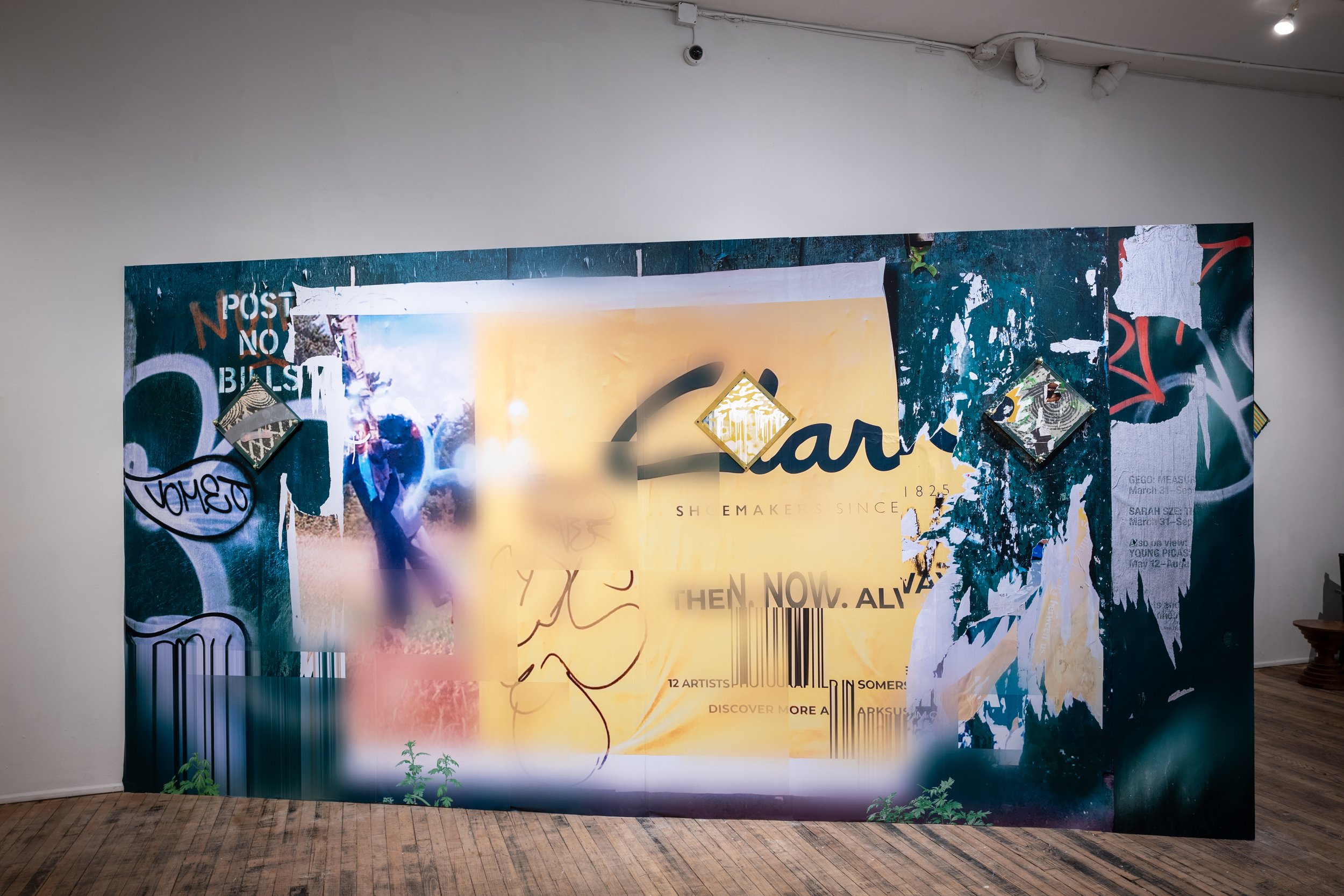



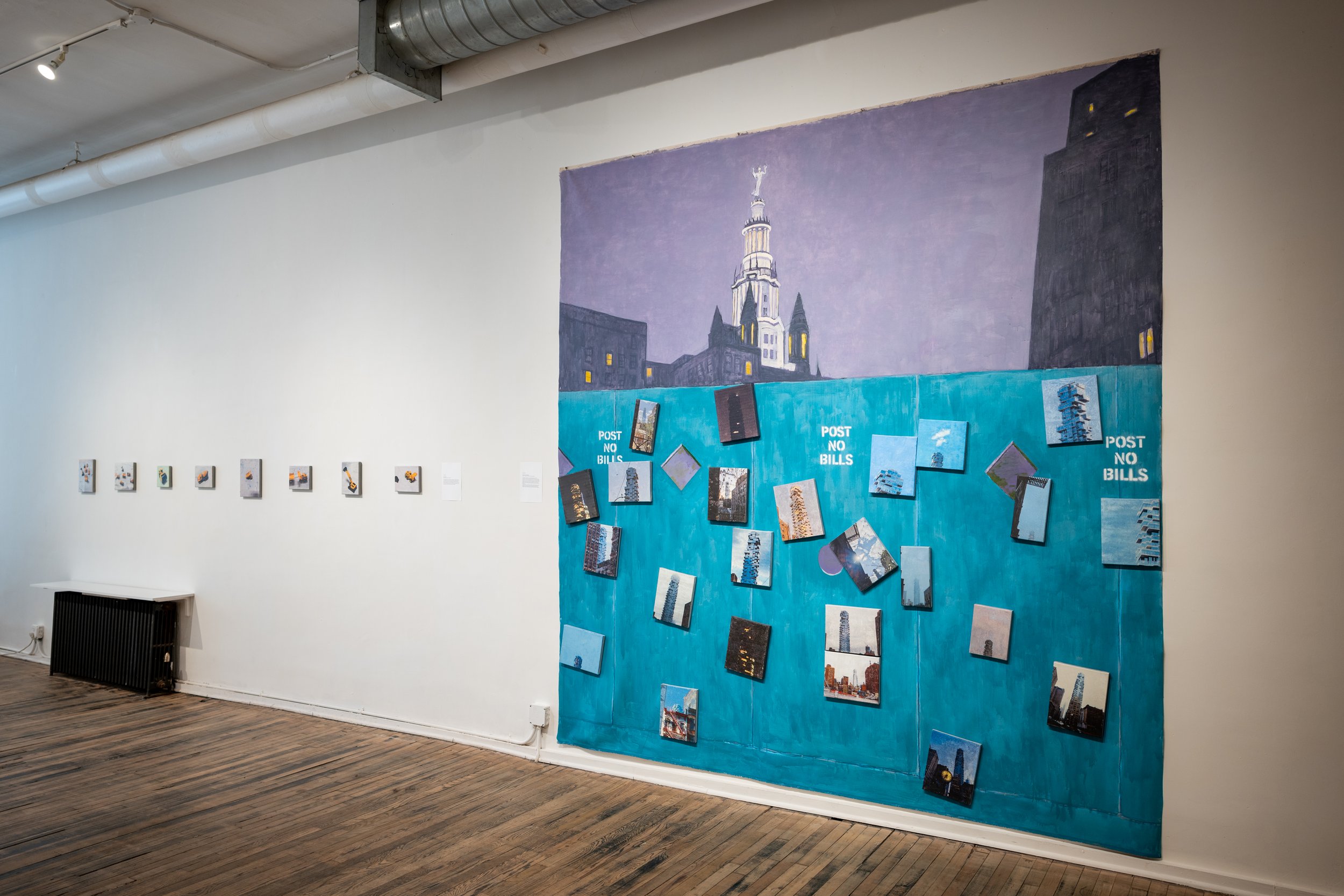

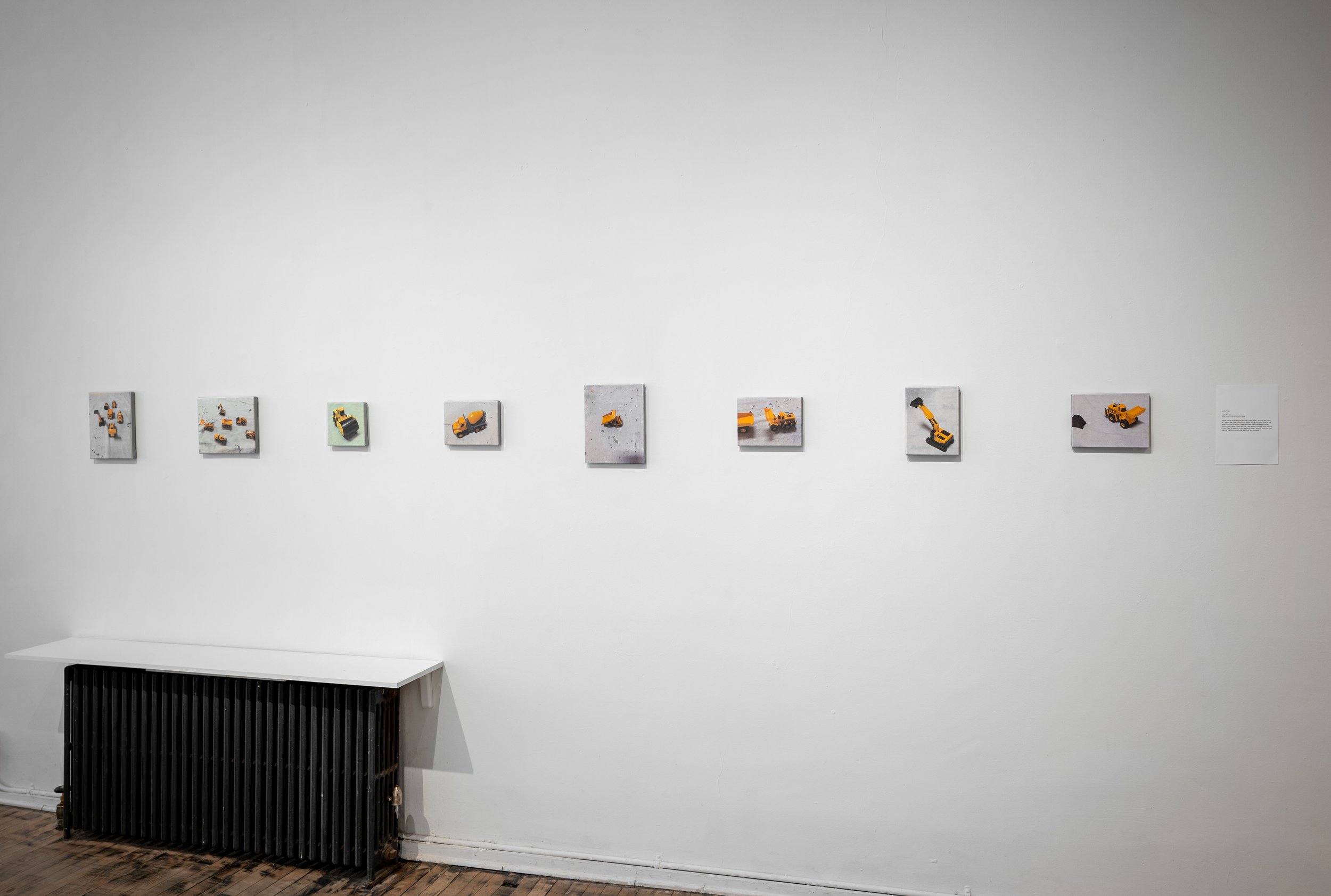
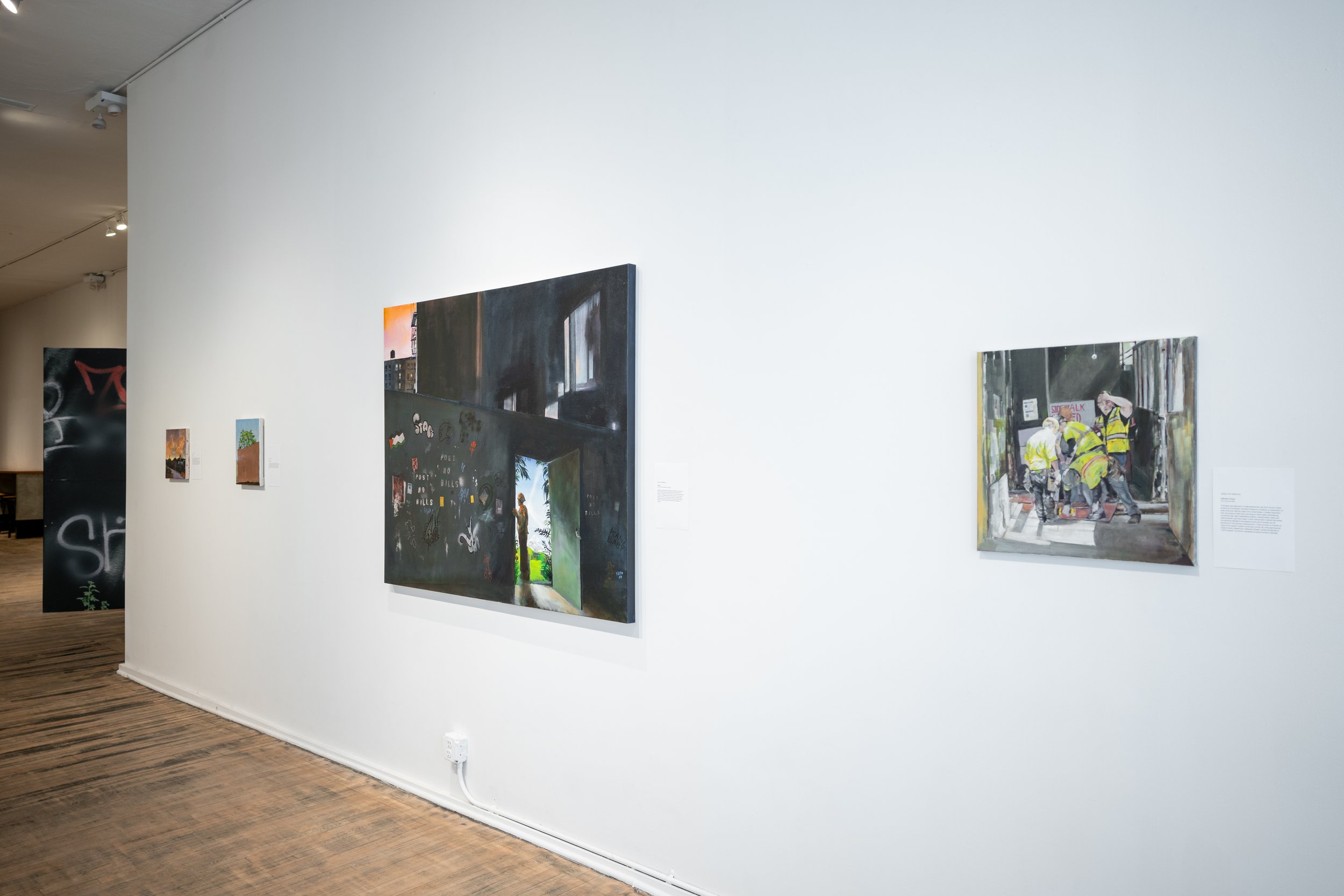
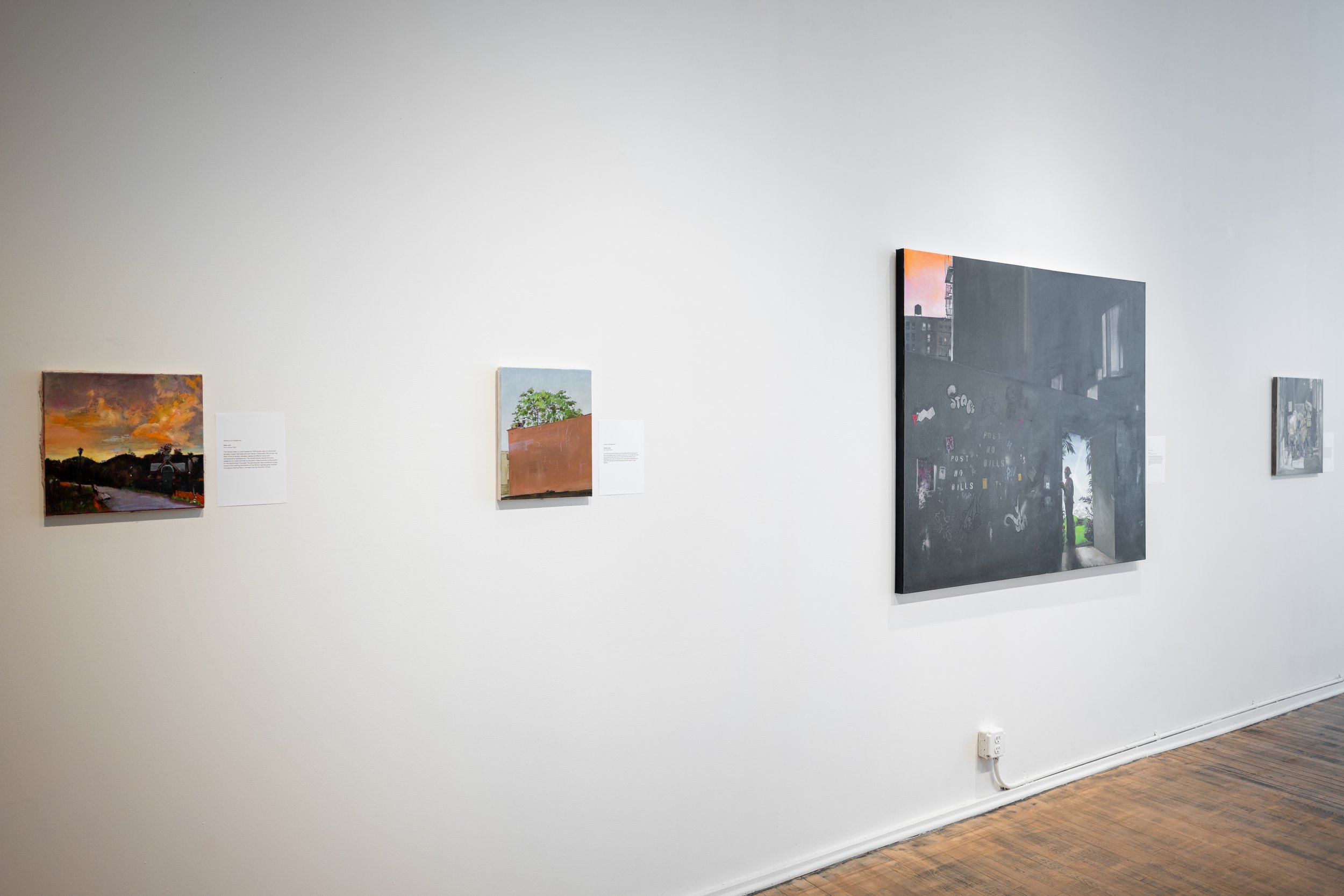
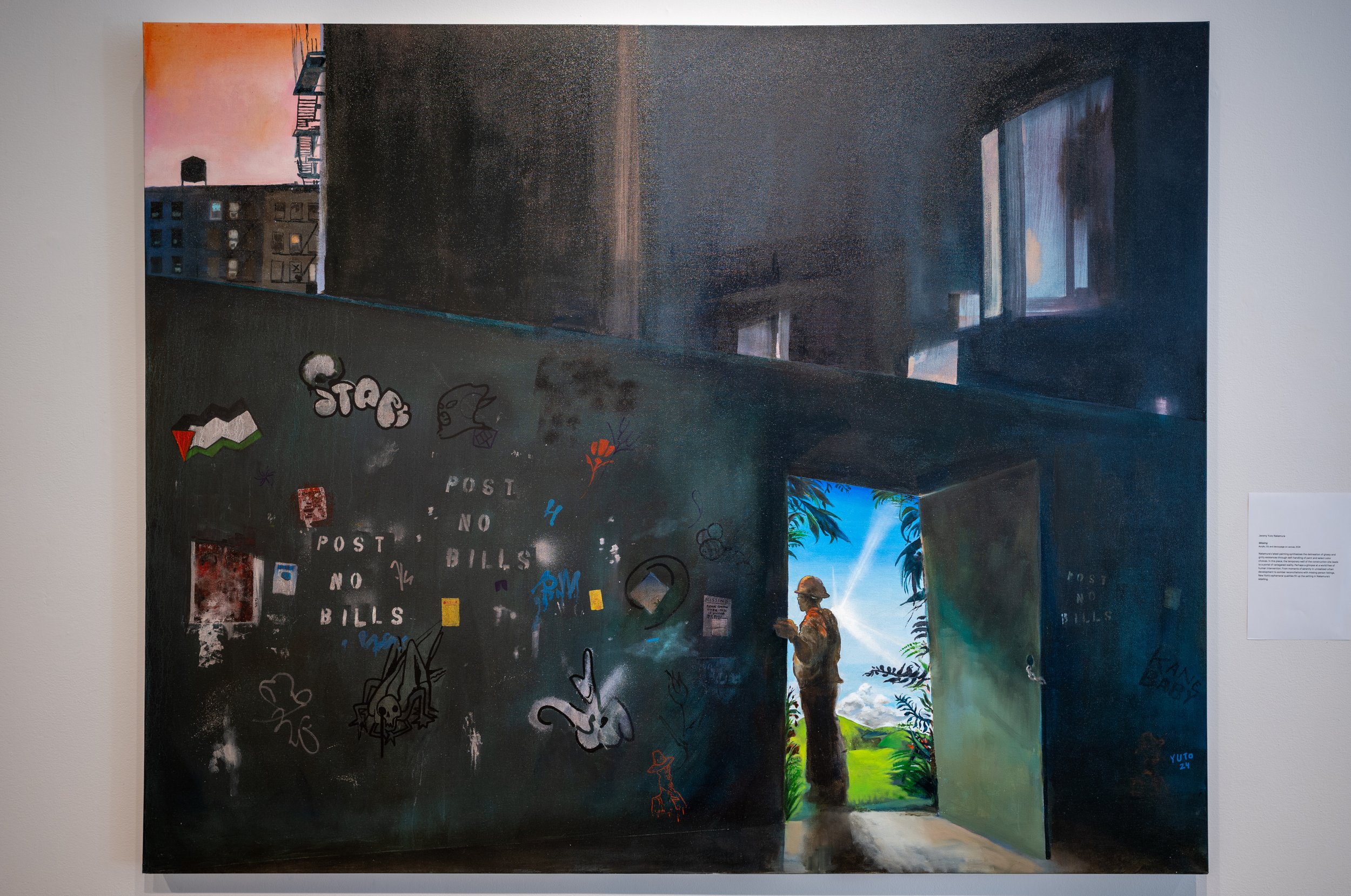
Hidenori Ishii
Born in Yonezawa, Japan, resides and works in LIC, New York. Ishii holds a BFA from George Mason University, Fairfax, VA, and an MFA from the Maryland Institute College of Art, Baltimore, MD. Ishii is a visual artist who explores the social and environmental landscape through a fusion of art historical connections, personal narratives, and socio-political subject matter. His work traverses painting, screen-printing, and installation. His solo exhibitions include venues like Erin Cluley Gallery in Dallas, TX, and C. Grimaldis Gallery in Baltimore, MD. Ishii's work has been featured in group exhibitions worldwide, including at the Wichita Falls Museum of Art in TX and Art in Embassies in Ankara, Turkey. He has received awards such as the 2022 New Work Grant from the Queens Council on the Arts and was previously a Keyholder Resident at the LES Printshop in New York City. Ishii's work is part of collections such as the Fidelity Investments Corporate Art Collection and the Microsoft Art Collection.
FTM(40.702985, -73.942753) – Green Bill Board
2020, Screenprint on fiber paper mounted on panel, collected acrylic sheet, cast urethane & wall
17 x 17 inches
INTERVIEW
FOLLOW THE MAP
– An interview with Hidenori Ishii
What are your feelings when you see a Post No Bills notice?
It’s a complex sentiment on various levels. For locals, green construction walls often symbolize gentrification, yet they also serve as a canvas for street artists and commercial posters. These walls act as physical dividers, signaling impending landscape changes, yet they will eventually be dismantled. Unlike border walls, they’re temporary and democratic, inviting artistic expression. In my FTM project, I employ green to symbolize US paper bills, exploring themes of gentrification and monetary value. The phrase Post No Bills takes on a fascinating double meaning for me, suggesting a post-currency world, potentially one dominated by cryptocurrency, originally conceived as a decentralized currency free from government control.
What is a favorite or memorable poster you have seen outside in the city?
I’m particularly drawn to the layers of torn and fresh posters overlapping each other. This creates dynamic visuals, an abstract collage of multiple commercial ads, imprints of people’s hands, and the passage of time against green walls.
If you could write any message on a public wall for the entire city to see, what would it say?
Assuming the color of the wall to be green, I’d write “PHOTOSYNTHESIS” in white.
Fumi Nagasaka
Born in Nagoya, Japan, Fumi Nagasaka moved to New York in 2002 to explore North American culture. In 2003 she began working as a freelance photographer for the Japanese cult magazine Street and later travelled around Europe and US shooting documentary photographs. Her work has been exhibited widely across Europe and Japan and was included in the Taylor Wessing Photographic Portrait Prize 2021 and 2023 Prize exhibition at the National Portrait Gallery, London, an open submission winner at Belfast Photo Festival in 2019 and the Photo Chronicles Portrait Photography Award in 2019. She exhibited her solo exhibition In America at Nowhere in April 2023 and published her 4th book Dora, Yerkwood, Walker County, Alabama with GOST Books in November 2023.
Untitled 2
2024, Archival Pigment Prints
20 x 24 inches
INTERVIEW
BACK IN NEW YORK
– An interview with Fumi Nagasaka
What are your feelings when you see a Post No Bills notice?
After I’m away for a while and I come home and see a Post No Bills notice, I feel like I am truly back in New York—you can always find one somewhere in the city. The construction wall I shot for this exhibition is near where I live, and I remember that it used to be an old building and I photographed some portraits in front of it. It’s sad that historical old buildings are disappearing.
What is a favorite or memorable poster you have seen outside in the city?
A photo of myself for a Uniqlo UT campaign. I was a friend of the photographer who was shooting the campaign, and back then I was a ‘rock chick’ with heavy bangs, so I think my look was interesting for them. They cast many people and I was just one of them, but seeing myself on the wall at the subway station and in the catalog was quite fun at the time.
If you could write any message on a public wall for the entire city to see, what would it say?
I don’t know? Maybe my website’s address?
Jeremy Yuto Nakamura
Jeremy Yuto Nakamura synthesizes the delineation of glossy and gritty existences through deft handling of figurative painting and select color choices. From moments of serenity in underrealized urban development to somber reconciliations with missing persons listings, New York’s ephemeral qualities fill up the setting in the artist’s retelling. In Nakamura’s latest piece, the temporary door on the construction site is literally a portal to a variegated reality. Nakamura is a visual artist who works in a variety of painting and drawing media. A mixed-race Japanese-American, his parents met in Kyoto, Japan while producing Mokuhanga (Woodblock printing) and Nihonga (Japanese Painting). Jeremy graduated from Connecticut College with a B.A. in Fine Arts, where he received support and encouragement from Timothy McDowell, Maureen McCabe, and Barkley Hendricks. After graduating, Nakamura kept practice through the Art Students League of New York. He has shown at the Godwin-Ternbach Museum at Queens College, Court Tree Collective, Chinatown Soup, the Art Students League, and the ISE Cultural Foundation.
Missing
2024, Acrylic, Oil, and decoupage on canvas
48 x 60 inches
INTERVIEW
CLASHING VOICES
– An interview with Jeremy Yuto Nakamura
What are your feelings when you see a Post No Bills notice?
When I was younger, it held a sense of mystery, as I only had a faint idea that it was in regard to property value. But I appreciate the natural cycle of preservation and degradation through people’s impulse to leave their mark.
What is a favorite or memorable poster you have seen outside in the city?
Just off the top of the dome, I remember the “Pouring on the Pounds” campaign commissioned by the Department of Health and Mental Hygiene. It was around the time when I was both gaining awareness of photo manipulation, with its ills and power to subvert, while also having fun learning how to photo- edit at home. The posters were these very visceral and super-saturated photo collages of raw animal fat pouring out of cans of soda.
If you could write any message on a public wall for the entire city to see, what would it say?
Maybe a bit saccharine (in step with my previous answer) but I would like to have a hyper-positive message such as, “Take care of each other.” It can be rough out there.
Junko Yoda
Junko Yoda was born in Tokushima, Japan in 1943. During her late college years at Musashino Art University in Tokyo, she saw a group show of fresh American paintings for the first time. The paintings, especially by Jackson Pollock never left her mind. In 1969, Junko moved to New York. She experienced the most exciting beginning of the American Art World in SoHo. Shortly after that, Junko changed her art materials from oil on canvas to acrylic and washi (Traditional Japanese Paper). Junko’s main subject matter through life has been terrain maps and the twisting course of a river from aerial view. All the paintings were made with washi. Some of her river paintings are collections of public museums and collectors. In 2005, Junko received a grant from The Pollock-Krasner Foundation. Ever since digital cameras appeared in the world, Junko added photograph as her new art material along with her regularly used materials. Junko was represented by New York’s pioneer gallery, Zabriskie Gallery for 32 years until the gallery closed permanently with Junko’s solo exhibition “Central Park” in 2010. Junko is busy capturing her subject matter with her camera and following up with the process she developed since her early years.
Post No Bills / TriBeCa Sky
2024, Acrylic on canvas (unstretched canvas) with 24 small canvases
118 x 113 inches
INTERVIEW
THEY CAUGHT MY EYE
– An interview with Junko Yoda
What are your feelings when you see a Post No Bills notice?
Every time I see the words “Post No Bills,” two questions come immediately to my mind. The first of the two is: “Which building used to be there?” The second question is: “And, now, what kind of building will go up in its place?” I also love to see the construction sites with earthmovers through the peepholes.
What is a favorite or memorable poster you have seen outside in the city?
It was the early 1980s. They were not posters, but instead they were graffiti. What I was seeing were Keith Haring’s first drawings, which were made in white chalk on the black paper panels that were in place for upcoming posters on subway platforms. They looked so fresh that they caught my eye.
If you could write any message on a public wall for the entire city to see, what would it say?
“IMAGINE”
Relative Contents
Shop
Post No Bills
Hidenori Ishii, Fumi Nagasaka,
Jeremy Yuto Nakamura and Junko Yoda
$30.00








